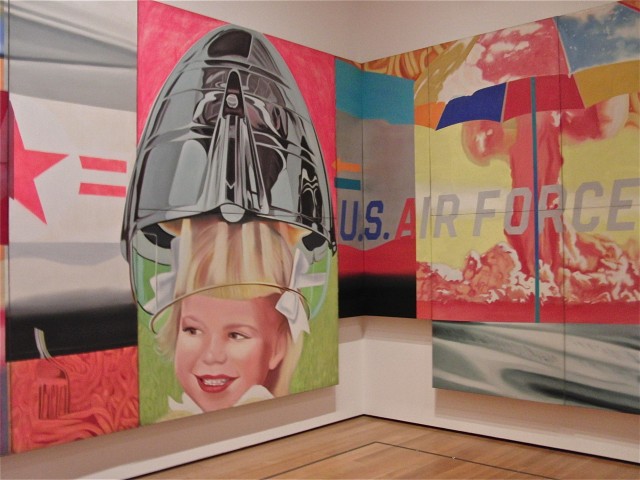Museum of Modern Art, fourth floor
11 West 53rd St. between Fifth & Sixth Aves.
Daily through July 30, $25 (includes same-day film screenings)
212-708-9400
www.moma.org
f-111 slideshow
First flown in December 1964 and officially deployed during the Vietnam War in 1967, General Dynamics’ $75 million F-111 Aardvark multipurpose tactical fighter bomber was a prime example of cutting-edge weaponry in its time, built with taxpayer money. In 1964, New York-based artist James Rosenquist, who grew up in North Dakota and Minnesota, raised by parents who were amateur pilots, began what would become one of his most powerful and influential installations, “F-111.” Designed as its own room, “F-111” has been reconstructed at MoMA and is being shown as it first was at the Leo Castelli Gallery in 1965, along with eight framed preparatory pieces that give insight into Rosenquist’s creative process. Resembling a four-walled billboard (Rosenquist was a former billboard painter), “F-111” consists of twenty-three colorful wraparound panels that meld consumer and advertising culture with ironic militaristic imagery. A pretty little girl is getting her hair done under the nose of the jet plane. A mushroom cloud is exploding under a rainbow umbrella. A fork is digging into spaghetti. Flags in a white cake proclaim its health benefits. A diver is swimming through a nuclear explosion. The eighty-six-foot-long mural took Pop art to another level, not merely re-creating familiar societal images but juxtaposing them with an instrument of mass destruction while the country was escalating its involvement in a controversial war. The immersive installation, inspired in part by Claude Monet’s large-scale works, provides a dizzying sensation of inescapable rapid-fire imagery that Rosenquist says on the Acoustiguide “felt to me like a plane flying through the flak of an economy.” Rosenquist, perhaps best known for paintings that look like they’ve been torn to reveal another work beneath it, here places his messages front and center, creating a visual collage of images that effortlessly flow into one another. On the audio tour the artist also notes that the plane’s “mission seemed obsolete before it was finished.” All these years later, Rosenquist’s “F-111” seems far from obsolete itself, perhaps even as relevant as ever.
